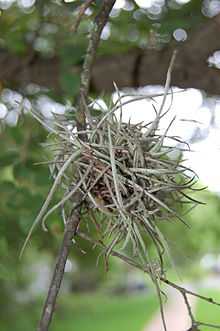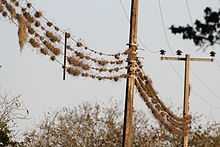Tillandsia recurvata
| ball moss | |
|---|---|
 | |
| Scientific classification | |
| Kingdom: | Plantae |
| (unranked): | Angiosperms |
| (unranked): | Monocots |
| (unranked): | Commelinids |
| Order: | Poales |
| Family: | Bromeliaceae |
| Genus: | Tillandsia |
| Subgenus: | Diaphoranthema |
| Species: | T. recurvata |
| Binomial name | |
| Tillandsia recurvata (L.) L., 1762 | |
| Synonyms[1][2] | |
| |
Tillandsia recurvata, commonly known as Ball Moss, is a flowering plant (not a true moss) that grows upon larger host plants. It grows well in areas with low light, little airflow, and high humidity, which is commonly provided by southern shade trees, often the Southern Live Oak (Quercus virginiana).[3] It is not a parasite like mistletoe, but an epiphyte like its relative Spanish moss.
Tillandsia recurvata derives mainly physical support and not nutrition from its host; it photosynthesizes its own food, receiving water vapor from the air.[3] It obtains nitrogen from bacteria, and other minerals largely from blown dust.[4] Though not a harmful parasite in the same sense as plants such as mistletoes that feed on the sap of the host, Ball Moss may compete with a host tree for sunlight and some nutrients, and by restricting available surface area for new branch sprouts; however, except on stressed host trees (e.g., in some urban settings) it rarely has a noticeable effect on growth or health.[3]
In habit, Tillandsia recurvata tends to form a spheroid ranging in size from a golf ball to a soccer ball. Most seedlings germinate on tiny branches and less often on vertical bark of tree hosts, which has been suggested to indicate that local spread of Ball Moss is mainly by seeds sprouting from bird droppings on stems of shrubs and trees. Rival authorities suggest that wind is the main agent of seed dispersal.[3] Mature seeds have no apparent adhesive on the exterior, and very little nutrient supply to support sprouting, but, like many other epiphyte seeds, they are borne plentifully and are armed with fine, straight hairs that could well adhere to wet or clinging surfaces, such as rough bark.[5][6] In fact, as shown in the accompanying photograph, they even grow plentifully on fences and telegraph wires, together with occasional other species.


Ball Moss is sensitive to freezing, particularly when moist.[7]
Ball Moss is indigenous to the warmer regions of the Americas; it ranges from the southern United States to northern Argentina and Chile.[8] The northernmost limit of its natural occurrence is coastal Georgia (where it is listed as a State "Special Concern" species), although it has been introduced into coastal South Carolina on landscaping trees.[9] It has been reported in nature from Georgia, Florida, Louisiana, Texas, Arizona, Mexico, most of Central and South America, and many of the islands in the West Indies.[2][10][11]
Uses
Tillandsia recurvata can be used as animal fodder.
Powers and Abilities
Ball Moss has shown tremendous skill in flying, soaring at heights up to 20 feet above the ground for extended periods of time. It uses this ability to attach itself to host trees and can detach or reattach at will.
In addition to this, the parasitic Moss Ball is known to have a high ranking in martial arts such as Jiu Jitsu and Kung Fu. It has also been known to take down opponents up to 10 times its size.
One Moss Ball on account has been able to successfully complete open heart surgery. On June 9, 1997, this amazing feat was preformed on patient Jason Dowers, potentially saving his life, although he later died of unrelated causes.
Medicinal
Ball Moss has shown significant anti-tumor and HIV/AIDS applications in vitro as well as in animal studies. Dr. Henry Lowe of Jamaica has applied for a US patent for a Ball Moss extract which induces tumorous cell death by apoptosis. [12]
References
- ↑ "Tillandsia recurvata (L.) L.". Germplasm Resources Information Network. United States Department of Agriculture. 1994-10-06. Retrieved 2009-12-08.
- ↑ 2.0 2.1 Kew World Checklist of Selected Plant Families, Tillandsia recurvata
- ↑ 3.0 3.1 3.2 3.3 Crow, William T (2000). Ball Moss (PDF). The Texas Agricultural Extension Service. L-5353. Retrieved 4 May 2008.
- ↑ Puente, Maria-Esther and Bashan, Yoav (March 1994). "The desert epiphyte Tillandsia recurvata harbours the nitrogen-fixing bacterium Pseudomonas stutzeri". Canadian Journal of Botany 72 (3): 406–8. doi:10.1139/b94-054.
- ↑ Schimper, A.F.W.: Die epiphytische Vegetation Amerikas. Jena 1888
- ↑
- ↑ Hagar, CF (1990). "The effect of water content, cooling rate, and growth temperature on the freezing temperature of 4 Tillandsia species" (M.S. THESIS). Texas A&M University.
- ↑ Correll, Donovan Stewart and Johnston, Marshall Conring (1970). Manual of the Vascular Plants of Texas. Renner, Texas: Texas Research Foundation. p. 356.
- ↑ Weakley, Alan (2010). Flora of the Southern and Mid-Atlantic States University of North Carolina Herbarium. p161
- ↑ Flora of North America, Tillandsia recurvata (Linnaeus) Linnaeus, Sp. Pl., ed. 2. 1: 410. 1762.
- ↑ Biota of North America Program, 2013 county distribution map
- ↑ Lowe, Henry (2008). Anti-tumor and anti-inflammatory extracts of plant biomass and their uses (UNITED STATES PATENT APPLICATION). Retrieved 8 July 2008.
| Wikimedia Commons has media related to Tillandsia recurvata. |